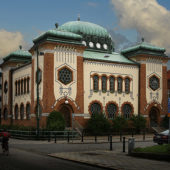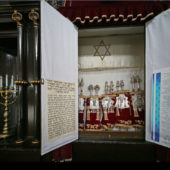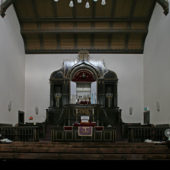The first documentation of Jews living in Malmo relates to a German Merchant named Isaac Leipziger, his wife, daughter and their servants in 1862. By 1870, 251 Jews lived in the Malmo region, with 209 actually living within the city limits. In 1871, the Malmo Mosaika congregation was established. Initially, offices were rented which served as the Synagogue. A Jewish cemetery was founded in 1872. By 1873 a community board was established and in 1895 a religious school was founded. Malmo community’s first Rabbi was hired in 1900, Dr. Joseph Wohlstein, at which time the congregation comprised approximately 1,000 members. Malmo was the third largest “Jewish” city in Sweden, following Stockholm and Goteburg.
In 1903, Malmo Synagogue was built, which is most likely the largest synagogue in Sweden. It follows the Orthodox tradition and is the only synagogue in the city. At the end of the 19th century, and in the beginning of the 20th century, many Jewish immigrants arrived from Russia, the Ukraine, Poland, and the Baltic countries. In 1910 Jews were granted full rights and equality before Swedish law. During the Holocaust, many Jewish Danes fled to Malmo and were welcomed to settle. After World War II, most of the Danes returned home. Survivors from all over Europe and the Soviety Union comprised a majority of the community. In 1967, when Jewish Poles fled Poland in the ‘Six Day War,’ another wave of immigrants arrived. In recent years, refugees from the former Soviet countries have been added to the community.
Malmo Synagogue was designed by architect John Smedberg and incorporates both Moorish Revival and Art Nouveau features. Its façade is highly unusual: concentric designs in blue and green glazed brick. Malmo Synagogue evokes strong Moorish elements, particularly in its exterior appearance, with its splendid copper-domed roof. This design choice might be considered interesting given that the synagogue’s congregants have always been Ashkenazi rather than Sephardic in origin. However, the choice could be seen as part of the late 19th century and early 20th century revival of the Moorish style that was sweeping through Europe and would eventually find its way to North America. A number of synagogues, including the Spanish Synagogue in Prague are examples of this resurgent theme during that era. Elements of this style are evident in the synagogue’s large hexagonal windows, and arcade style windows as well as in its variegated brickwork.
The four tower-like corners of this blocky building, suggest minarets topped with “squashed” domes. Meanwhile, a main central dome tops the structure with smaller windows inset around the dome’s base, each with a Mogen David design. Inside, the synagogue departs from the traditional Moorish revival style that in many other synagogues manifests in elaborate floral designs, a vibrant paint color palette, stunning arabesques and other geometric motif. Instead, Malmo Synagogue opts for an almost Nordic simplicity with ivory colored walls with wood from the pews to the wood beans and planks in the ceiling, as well as parquet wood flooring. A massive, beautifully carved wooden structure frames the Aron-Kodesh against the East wall, on a bimah. It is stained a very dark wood, with gilded accents. Two tablets are carved into the top of the Aron-Kodesh, featuring The Ten Commandments, inscribed in Hebrew. A maroon Torah curtain is draped across the front, with a beautiful maroon pelmet featuring gold embroidery and a Hebrew inscription. A large tivah (reader’s desk), sits in front of the Aron-Kodesh and it is several steps down to the main platform of the bimah, with carved balustrades on each side. Across the front of the bimah is a paneled structure in the middle, with balustraudes at the sides. A large chandelier dangles from the center of the dome. An upstairs balcony, against the back and side walls, provides seating for women as is customary for orthodox congregations.
The Synagogue was bombed on July 23, 2010, which caused significant damage to the building. The day prior to the bombing, a note had been taped to the door of the Synagogue, threatening that it would be bombed. In Malmö, in March of 2009, violent anti-Israel demonstrations occurred when an Israeli tennis player played a Swedish player in a Davis cup round held in Båstad, Sweden. The city itself has become somewhat of a hotbed of anti-Semite and anti-Israeli sentiment. With an increasing influx of Muslims into Malmo, hostilities against Jews have been on the increase with 79 incidents including graffiti, threats, defacing of buildings and even a firebombing at a Jewish burial site. Security has been increased at synagogue services.
Today, the Synagogue continues to serve its community of 1300 members. It is open for weekly services and High Holidays. The community also has a mikvah (ritual bath), a kosher corner in the local shop, a kosher restaurant, Jewish youth clubs, and a kindergarten. There is a group called ‘Holocaust’s Eyewitness,’ who visit schools to assist with Holocaust education, teaching about the terrible effects of prejudice and discrimination.
Malmo Synagogue has been a beacon of hope to Europe for over a century. It comprises a strong community with which it continues to take a brave stand to promote Jewish culture, tradition and faith, amidst much persecution.
Photographer’s Note:
We traveled to Malmo to photograph the Synagogue in September of 2006. The synagogue was locked but with the help of a pleasant lady who was opening a small art gallery nearby, we found the Jewish community center. There was security and we were buzzed in. We were cordially greeted by the executive director of the Jewish community of Malmo who was pleased that the Malmo Synagogue would be included in the Synagogues360 photographic archive.
The director gave us information sheets about the Synagogue and Jewish Community, and then said he would take us to see the synagogue. He explained however, he didn’t have the key because his key was stolen when his car had been recently vandalized. So, he excused himself to call the Synagogue caretaker, who was at home for lunch break, to bring a key. A few minutes later the director received a phone call from the caretaker. The caretaker said that when he had gone out to get his bike to bring the key, he found his bike had been stolen! Using our car, we drove with the director to pick up the caretaker and the key in order to visit and photograph the synagogue.



